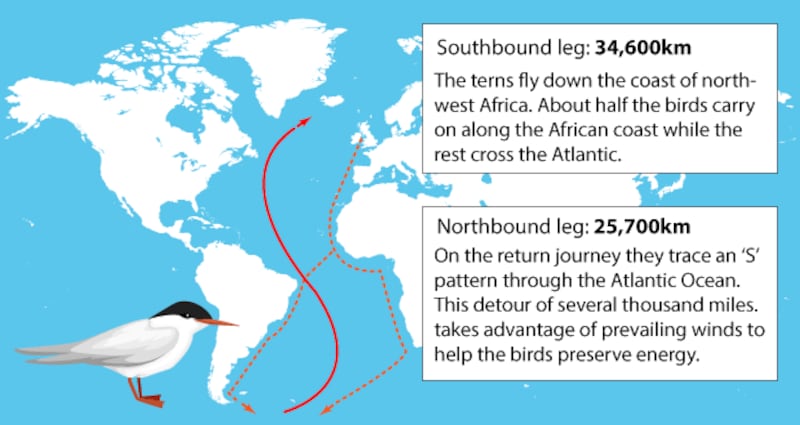The removal of a large rat population from Dalkey island has resulted in the successful breeding of rare Arctic tern chicks for the first time on record.
In a unique conservation project, six of the rare chicks have been successfully raised on the main island of the uninhabited archipelago some 300m off the coast of south Co Dublin.
The project has given the vulnerable colony, which is protected by BirdWatch Ireland, a much-needed lift.
So far six chicks have taken to the wing from the island, with a seventh expected to take its first flight over the next few days.
A spokesman for Birdwatch Ireland said it had been worried about the future of the birds on the small island and across Ireland in general.
One of the reasons for this is that the availability of suitable breeding habitat, namely undisturbed rat- and mink-free offshore islands, is quite limited. To tackle this, BirdWatch Ireland carried out rat-baiting across Dalkey island and nearby Lamb island before this year’s nesting season.
Canes were also erected across a portion of Lamb island to exclude gulls from the tern colony.
Tara Adcock, BirdWatch Ireland’s Dalkey tern warden, is delighted by the project’s success. “This project truly shows that if you give nature a chance, it can bounce back. It has been a real pleasure to work to protect these phenomenal birds. It’s incredible to think that in a few weeks, these chicks, along with their parents will undertake the longest migration in the natural world, all the way to the Antarctic.”
Long-distance star
The Arctic tern, nicknamed “sea swallow” after its long tail streamers and buoyant flight, is the world’s greatest long-distance traveller, migrating further than any other animal.
During our summer months, they breed in Ireland and other areas of the Northern Hemisphere and then fly all the way to the Southern Ocean, off Antarctica, where they wait out the northern winter. This means that they see more daylight each year than any other creature on the planet.

Throughout the course of their lives Arctic terns can travel more than three million kilometres; an especially impressive achievement for a bird that weighs just 100g.
To put the overall distance which these birds travel into context, they migrate the equivalent of almost four round trips to the moon over the course of their lives (25-30 years).
Ms Adcock said BirdWatch Ireland was thrilled with “how well this small but resilient colony has done this year.
“Prior to this season, chicks surviving past two weeks, never mind fledging from Dalkey island itself, was unheard of.
"This is thanks to management from BirdWatch Ireland staff and volunteers, support and funding from the EU Life Roseate Tern Recovery Project and Dún Laoghaire Rathdown County Council, advice from the RSPB [Royal Society for the Protection of Birds] and the tenacity of the Arctic tern parents themselves."
Lamb fledglings
On top of the success on Dalkey island, Lamb island has also confirmed six fledglings, but the true figure is thought to be higher, with a further nine chicks waiting in the wings. Lamb island is a small, flat-topped granite islet that can be accessed on foot at low tides from the main island.
The four uninhabited islands of the archipelago are under the management of Dún Laoghaire Rathdown County Council and officially form one of its public parks. They are separated from the mainland by Dalkey Sound. The main island is 11.2 hectares and a humpback shape with one designated place for boats to land.
There is evidence of human occupation on the islands from Mesolithic times. Dalkey island is home to the remains of a 10th-century church – a national monument – as well as an early medieval promontory fort and a Martello tower and gun battery. There is also a holy well on the island, the Scurvy Well. Rare plants have also been recorded on the island. An informal ferry service operates to the main island.









